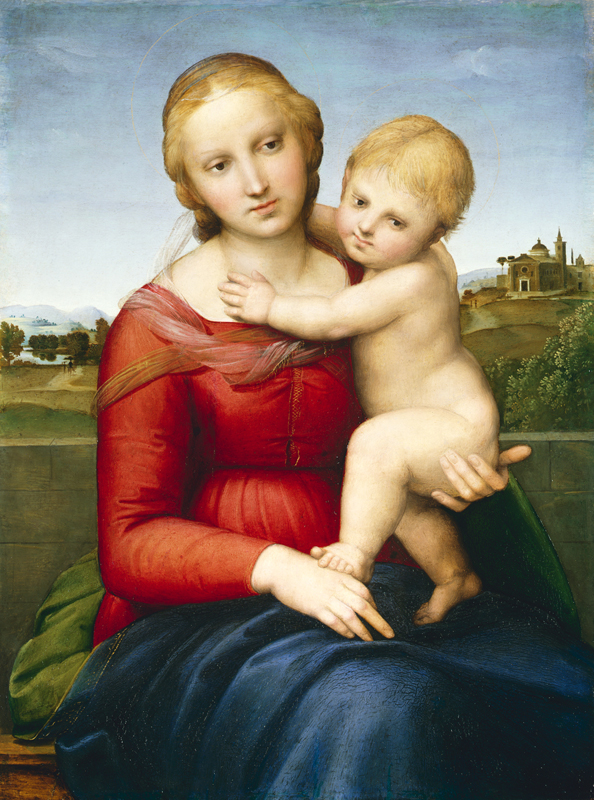Raphael's "The Small Cowper Madonna" on Loan from the National Gallery of Art, Washington
Panshanger, the Hertfordshire seat of the Earls of Cowper, built around 1804, once contained one of the finest collections of Renaissance paintings in England. The gallery was largely assembled by George Nassau Clavering, the third Earl Cowper (1738-1789), who set off on his grand tour in 1760 and remained in Italy for the rest of his life. In his Florentine residence in the Via Ghibellina, as well as his villas outside of the city, he amassed a remarkable collection of paintings by Italian Renaissance artists such as Correggio, Fra Bartolomeo, Andrea del Sarto and Titian, but of uppermost importance and rarity were two early panels by Raphael depicting the Madonna and Child. Both now reside at the National Gallery of Art in Washington, D.C. From November 2010 through January 2011, one of these, painted around 1505 and called The Small Cowper Madonna (given its slightly smaller size than the Niccolini-Cowper Madonna of 1508), is on display in Pasadena alongside the Norton Simon Art Foundation's own Madonna and Child with Book by Raphael, painted slightly earlier in the artist's formative career and the only painting by the artist in a collection west of Washington, D.C.
Raphael was born on Good Friday, 1483, in the hill town of Urbino in central Italy. The son of Giovanni Santi, himself a painter in service to the Court of Urbino, Raphael's earliest works date to around 1500. He was orphaned by age 11, and, under the care of his uncle Bartolomeo, a priest, he would achieve fame and important religious commissions well before his 20th birthday. In the course of just two decades he gained the respect and admiration of Urbino's Ducal Court and artistic circles in Florence and Rome, as well as the patronage of two powerful popes. The youthful Raphael's inspirations and influences were garnered in Urbino and in his early travels to Perugia, Città di Castello, Orvieto and Siena. The young painter was surely impressed by his father's work, as well as the graceful, classicizing postures and landscapes in paintings by Signorelli and Perugino. Florence and Rome, and the attendant artistic flurries of Fra Bartolomeo, Leonardo and Michelangelo, would ultimately astonish him and mark his mature style.
It is remarkable that the Simon and the two National Gallery Raphaels, all painted in the same decade, were at one time-perhaps as early as the 1850s until the 1920s-only 80 miles away from each other in the eastern English countryside. After the third Earl Cowper's death in 1789 in Florence, his collection was shipped to his heirs. It was eventually housed by the fifth Lord Cowper at Panshanger, where the collection would then reside for over 120 years. Meanwhile, toward southeast Kent, by at least the 1880s the Simon Raphael was hanging at Syndale Park, the home of the Townend family, in whose possession the Pasadena picture remained until the 1950s. This trajectory was, for the most part, the same as for the dozen or so panels by Raphael that came to be in American museums: from motherland to England via the grand tour in the 18th century, and then on to American shores by the Gilded Age and the first half of the 20th century, initially to be privately owned, and finally to be housed in public museums.
This extraordinary and generous loan is part of an exchange program between the National Gallery and the Norton Simon Art Foundation, the first loan of which brought Vermeer's ravishing A Lady Writing to Pasadena in the fall of 2008. The Gallery's Small Cowper Madonna is one of an astonishing five panels by Raphael at the National Gallery. It is rarely lent, and its presence in Southern California marks the first time it has been west of its adopted home on Constitution Avenue. Lectures by David Alan Brown, the Curator of Italian Paintings at the National Gallery and author of Raphael and America, an exhibition catalogue prepared in 1983 on the 500th anniversary of Raphael's birth, and by Linda Wolk-Simon, a curator and Raphael scholar from the Metropolitan Museum of Art in New York, are two of the special events planned to commemorate this munificent loan.

